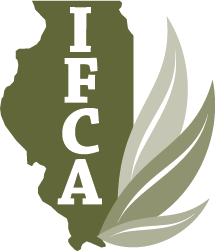New Special Local Needs Labels for Dicamba - July 15 Cut-Off & Guidance
The Illinois Department of Ag has accepted revised 24(c) Special Local Needs (SLN) labels from the four registrants of dicamba for the products Engenia, FeXapan, Xtendimax and Tavium. To download the base labels and the new SLN labels click here. This area on the IFCA website has many helpful resources on dicamba stewardship.
We want to make it crystal clear how the new July 15, 2019 cut-off date for application of these products to soybean works.
There are several cut-off parameters for dicamba application, July 15 being only one of them. IF ANY ONE OF THE FOLLOWING FACTORS OCCUR BEFORE JULY 15, YOU CANNOT APPLY DICAMBA TO SOYBEAN:
1. 45 days have passed since the dicamba tolerant soybeans were planted;
2. The dicamba tolerant soybeans reach R1 stage (flowering);
3. If using Tavium (dicamba/s-metolachlor premix) the soybeans reach V4 development stage.
When it comes to the 45 days after planting restriction, if you as a commercial applicator have any question in your mind about when your farmer customer planted their beans and you are requested to treat the beans with dicamba in July, you should ask the farmer to document either in writing or in a voice mail the date they planted the beans. IFCA also recommends that you request your customers identify in writing to you the traits of all soybeans planted adjacent to the field where they desire a dicamba application.
Buffers: All dicamba application to soybean must have a 110 downwind buffer, and if you are applying in one of the counties where USEPA has identified an endangered species, you must also comply with the 57 foot omnidirectional buffer. To see the map of counties with endangered species click here.
The SLN labels in Illinois also make it clear that you CANNOT APPLY dicamba to soybean if there is a residential area that is adjacent, neighboring and downwind. You must also check Fieldwatch to identify and document the location of sensitive specialty crops and you must check for DNR Nature Preserve Commission sites which are also sensitive, and apply the 110 buffer to protect these DNR Nature Preserve sites. A feature to check for DNR sites in your area and download GIS files is featured on the IFCA homepage. It is critical to protect ALL sensitive areas, sensitive plants and trees from exposure to dicamba in order to preserve this technology. When in doubt, do not apply.
The University of Tennessee advises that to reduce dicamba volatility, you should carefully monitor the pH of your tank mix. To reduce volatility, they advise against tank mixing dicamba with glyphosate particularly when air temperatures reach or exceed 85 degrees. To read the U-TN article on this research click here.
Finally, we want to give you an update of what is occurring in other states relative to dicamba use on soybean:
1. The Minnesota Dept of Ag announced they would NOT be extending their June 20, 2019 dicamba cut-off date.
2. The South Dakota Dept of Ag has not indicated that they will extend their June 30, 2019 cut-off date.
3. The cut-off date in Arkansas was May 25. Reports are starting to come in of dicamba symptoms in sensitive soybean and in trees.
4. In Illinois, there are already 30 ag-related pesticide misuse complaints filed with IDA as of last week (not necessarily dicamba related at this point).
If you have questions about dicamba stewardship or use, please contact IFCA.
